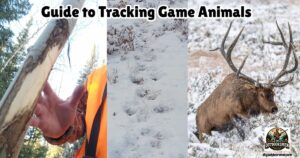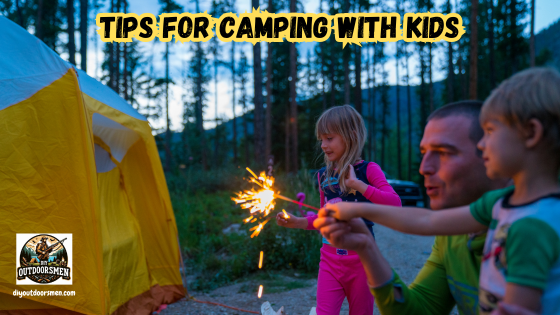Contents
- 1 Planning a Successful Camping Trip With Kids
- 2 Preparing for the Trip and Involving Kids When Organizing Essentials
- 3 Tips for On-Site Camp Setup and Safety
- 4 Creative and Fun Activities at the Campsite
- 5 Addressing Common Camping Challenges
- 6 Additional Tips for a Rewarding Experience
- 7 Extra Tips and Learning Opportunities for Family Camping
- 8 Frequently Asked Questions about Camping with Kids
- 9 Final Thoughts on Camping With Kids
Camping with kids can be a rewarding experience when proper planning and preparation guide each step of the way. I have found that involving children in the planning process helps them feel excited and responsible during the trip. In this article, I share practical advice and creative ideas to help families enjoy memorable outdoor adventures.
QUICK LOOK: 7 Tips for Camping with Kids
- Get Them Involved in Planning: I like to encourage children to pack small items of their own, such as a favorite toy or a book, so they feel connected to their personal space in the tent.
- Think Safety First: Discuss important topics, such as proper campfire behavior, staying within designated areas, and what to do if they feel unsure about a situation. This proactive approach ensures that safety is a shared priority. When kids learn to follow guidelines, they feel more secure.
- Let Them Help Set up Camp: Getting kids involved during the camp setup not only makes the process more engaging but also teaches them valuable life skills. Simple tasks, such as helping to unpack or gather firewood, make them feel like they are genuinely contributing to the family effort.
- Plan Fun Activities: I have found that a mix of structured activities and free play works well to keep children entertained without overplanning their time. The key is to blend playful games with moments of relaxation, providing both active play and quiet moments for reflection.
- Be Prepared for Weather Changes: Managing weather conditions is vital when camping with young ones. I pack raincoats, waterproof boots, and extra blankets to keep everyone warm and dry. Scheduling indoor activities as a backup during a storm also helps ease any stress.
- Keep Them Engaged: Children may lose interest in planned activities if they feel overwhelmed or unsure. I make sure to include a mix of organized and quiet time activities so that they are never bored.
- Encourage Curiosity: When kids feel that their curiosity is welcomed, it creates an engaging learning atmosphere that nurtures respect for the natural world and builds an appreciation for simple yet meaningful experiences.
Planning a Successful Camping Trip With Kids
Setting out on a camping trip with children begins long before you enter the campsite. It starts with designing an itinerary that takes into account simple tasks and familiar comforts. I believe that clear planning makes it easier to control the environment and meet the needs of younger campers.
Simple steps such as organizing gear in advance and discussing daily activities help build excitement and ensure everyone is on the same page. Involving kids in planning creates a sense of accomplishment. I ask the children to help decide on meals, choose fun activities, and even select the campsite if options are available.
This early participation can ease any anxiety they might have, making the concept of sleeping in a tent less intimidating. Clear communication about timeframes and what to expect is also helpful for both children and adults.
When plans are laid out well in advance, unexpected challenges become easier to manage, and the anticipation of a new adventure turns into a shared experience that the whole family enjoys.
Preparing for the Trip and Involving Kids When Organizing Essentials
Before leaving home, it is essential to ensure everyone is prepared. I like to encourage children to pack small items of their own, such as a favorite toy or a book, so they feel connected to their personal space in the tent. Having personal items available often comforts children when they are exposed to new surroundings in nature.
Efficient organization is part of a successful camping trip. I recommend using clear storage boxes or a designated camping bag to keep gear within reach. When each family member has a role in getting the equipment organized, the workload feels shared and less overwhelming. Simple checklists that include essentials like raincoats, snacks, and extra layers of clothing help ensure nothing is forgotten when packing.
- Involve the Kids: Let them help select activities and pack their own items.
- Try a Practice Camp: Setting up a tent in the backyard or even inside the house can help children adjust to the idea of camping.
- Choose a Kid-Friendly Campsite: Look for areas near playgrounds with restroom facilities and safe surroundings.
- Plan Simple Meals: Prepare easy-to-make meals and grab-and-go snacks to avoid stress when cooking outdoors.
This level of preparation helps create a smooth transition from home to the great outdoors and minimizes any feelings of unease children might have. Knowing what to expect and having a well-organized schedule can transform a tentative camping experience into a fun family outing.
Tips for On-Site Camp Setup and Safety
Arriving at the campsite early allows everyone to settle in comfortably before the sun starts to disappear. I always aim to set up the tent and organize our camping space while natural light is plentiful. This practical approach eases the transition into a new environment and gives children the opportunity to explore their surroundings safely.
Getting kids involved during the camp setup not only makes the process more engaging but also teaches them valuable life skills. Simple tasks, such as helping to unpack or gather firewood, make them feel like they are genuinely contributing to the family effort. I ensure that children understand basic safety rules, such as not wandering off, how to behave near the campfire, and what to do in case of sudden weather changes.
- Set Up Early: Arriving before dark helps reduce stress when setting up tents and arranging essentials.
- Assign Simple Tasks: Have children help with safe and manageable tasks like sorting camping gear or collecting nearby sticks for the fire.
- Review Safety Rules: Discuss important topics, such as proper campfire behavior, staying within designated areas, and what to do if they feel unsure about a situation.
This proactive approach ensures that safety is a shared priority. When kids learn to follow guidelines, they feel more secure. Moreover, setting up in daylight leaves plenty of time for both adults and children to get acquainted with their surroundings.
Creative and Fun Activities at the Campsite
The outdoors provide endless opportunities for fun activities that bring family members closer together. I have found that a mix of structured activities and free play works well to keep children entertained without overplanning their time. The key is to blend playful games with moments of relaxation, providing both active play and quiet moments for reflection.
One great way to engage children is through scavenger hunts. I prepare simple lists of natural objects, such as uniquely shaped leaves, interesting rocks, or even traces of animal tracks that children can find along the trails.
These games add an element of adventure, shifting focus onto the beauty of nature. Besides scavenger hunts, organized campfire games and nightly stargazing have become favorites among kids. Each activity can be tailored to different age groups and interests, creating cherished memories while connecting everyone with the wonders of nature.
- Nature Walks: Take a walk along easy trails and chat about local plants and wildlife.
- Scavenger Hunts: Create simple item lists for children to find during a walk, adding a playful challenge to the outing.
- Canoeing, Kayaking, watersports: If you are camping near water, watersports can entertain the entire family.
- Campfire Story Time: Share family-friendly stories or legends near a safe, warm campfire.
- Star Watching: After dinner, lie on a blanket and observe the night sky, discussing constellations and familiar shapes in the stars.
The natural surroundings offer a dynamic backdrop for imaginative play. Simple outdoor games also help children expend energy in a healthy manner. By balancing planned activities with free time, I ensure that children enjoy the outdoors without feeling over-scheduled. This thoughtful blend creates opportunities for relaxation and nurtures a genuine interest in exploring nature.
Addressing Common Camping Challenges
Camping with kids sometimes presents unexpected challenges. I always plan for disruptions such as variable weather conditions, moments when children might feel bored, or minor inconveniences that come with being away from home. Anticipating these issues helps keep the mood upbeat and ensures that the trip remains enjoyable for everyone.
One area I pay close attention to is the weather. It is really important to pack enough layers of clothing and rain gear. I always check local forecasts before leaving and pack extra clothing for sudden temperature shifts. Children can catch a cold quickly if they are not dressed properly, which can put a damper on the vacation.
Weather Preparations
Managing weather conditions is vital when camping with young ones. I pack raincoats, waterproof boots, and extra blankets to keep everyone warm and dry. Scheduling indoor activities as a backup during a storm also helps ease any stress. Being prepared for both rain and shine means that the camping experience continues to be enjoyable regardless of the weather.
Keeping Kids Engaged
Children may lose interest in planned activities if they feel overwhelmed or unsure. I make sure to include a mix of organized and quiet time activities so that they are never bored. Simple board games, art supplies for drawing what they see in nature, or even a few favorite indoor stories can be lifesavers during a lull in outdoor adventures.
Managing Outdoor Surprises
Encountering unexpected outdoor surprises, like stray critters or insects, can unsettle children. I use these moments as opportunities to educate them about the natural world. Explaining the role of every creature and showing how to observe nature without disturbing nature can turn a potentially negative incident into a valuable lesson.
This proactive strategy makes it easier for everyone to approach surprises with a calm attitude. Understanding these common challenges beforehand helps me adjust plans as needed. This preparedness not only reassures children but also allows for flexible scheduling, ensuring a smooth and enjoyable camping experience.
Additional Tips for a Rewarding Experience
Plan for Rest and Flexibility: I understand that children sometimes need a break. While the schedule might be packed with fun, incorporating downtime ensures that kids have time to relax and adjust to a slower pace. This helps prevent overtiredness and maintains a positive overall mood.
Encourage Curiosity and Exploration: I invite children to ask questions about nature and explore responsibly. When kids feel that their curiosity is welcomed, it creates an engaging learning atmosphere that nurtures respect for the natural world and builds an appreciation for simple yet meaningful experiences.
Embrace Imperfection: Outdoor adventures rarely go exactly as planned. I accept that small mishaps or unexpected changes are simply part of the adventure. This mindset teaches children that every experience, even an imperfect one, has its own charm and valuable lessons. Focusing on the positive aspects and learning from surprises make the trip more memorable for everyone involved.
These additional suggestions serve as gentle reminders that flexibility and a positive outlook are very important. I have learned that the best camping trips with kids often come from adapting to circumstances and finding joy in every simple moment instead of rigidly following a plan.
Extra Tips and Learning Opportunities for Family Camping
Beyond careful planning and preparation, camping offers a unique opportunity to create an all-in-one learning adventure for the whole family. Being outdoors provides a natural laboratory where families can explore science, nature, and history all at once.
Whether discussing the behavior of local wildlife or examining the different types of plants, every moment outside becomes a chance to pick up on lessons that textbooks seldom capture. These quiet moments not only spark curiosity but also encourage a sense of wonder at the world around us.
Sharing stories around the campfire can also help extend the learning experience. For example, parents might recall tales of their own outdoor adventures, describing how the changing seasons influenced their daily lives. Such stories not only entertain but also help children understand that nature is full of surprises and learning opportunities.
Sometimes, engaging in a simple craft session using materials found in nature can turn the camping trip into a dynamic creative session. These activities encourage family bonding and allow children to express what they have experienced in imaginative ways.
Moreover, taking time to journal or sketch in a nature diary gives everyone a creative outlet to record their adventures. This practice helps reinforce memories and provides a personal record of discoveries made during the trip.
Encouraging children to process their experiences by drawing or writing about what they saw and felt can add an extra layer of meaning to the journey. Overall, these extra activities not only enrich the outdoor experience but also transform a simple camping trip into a lasting, multifaceted adventure for the entire family.
Frequently Asked Questions about Camping with Kids
Many families have questions about camping with kids, and I am happy to share insights drawn from personal experience.
What is the best way to get children excited about a camping trip?
I involve them in every part of the planning process. From choosing activities and packing personal comfort items to trying out practice camps in the backyard, children begin to connect with the adventure even before you leave home.
How can I make sure my children stay safe at the campsite?
Setting clear safety guidelines is very important. I discuss rules such as staying near the tent, handling campfires with care, and knowing what to do if they feel lost or scared. This routine reassures the children and helps keep everyone safe.
What activities work best for children during a camping trip?
Simple and creative activities like scavenger hunts, nature walks, campfire storytelling, and stargazing keep children engaged. Tailoring these activities to the ages and interests of your kids ensures that everyone has a great time.
How do you deal with unexpected weather or other challenges while camping?
I always check weather forecasts before a trip and pack extra clothing and gear for unpredictable conditions. Keeping a flexible schedule allows us to shift indoor activities forward when necessary, ensuring that the fun never really stops, even if the weather changes.
Final Thoughts on Camping With Kids
The experiences shared during a camping trip with children leave a lasting impact because they combine learning, adventure, and quality family time. I value how nature transforms into both a classroom and a place for exploration. Every camping trip—whether perfectly planned or full of surprises—offers a chance to create stories that last a lifetime.
Successful camping with kids is built on preparation, involvement, and the willingness to adjust plans when needed. When families work together to set up camp, create fun activities, and face challenges with a positive attitude, the outdoors become a space for growth and genuine connection. I hope these ideas and practical tips help families achieve rewarding camping experiences that nurture not only adventure but also the warmth of family bonds.
Check Out Our Latest Articles:
- Complete Guide On Tracking Game Animals

- DIY 4-Step Guide To Field Dressing And Quartering A Deer

- Night Vision Binoculars For Nocturnal Hunting

- The Science Behind Camouflage Patterns For Deer Hunting

- Binocular Accessories For Hunters

- 9 Tips for Using Trail Cameras To Track Deer Movements

As always, stay safe, enjoy the journey, and please try to leave it cleaner than you found it. If you have any comments, questions, ideas, or suggestions, please leave them in the comment section below, and I’ll get back to you ASAP. You can follow us on YouTube: Man Art Creations for videos of our DIY Adventures.
P.S. Thanks so much for checking out our blog; we really appreciate it. Just so you know, we may receive a commission if you click on some of the links that appear on our site. This helps us keep our content free and up-to-date for everyone. We appreciate your support!



